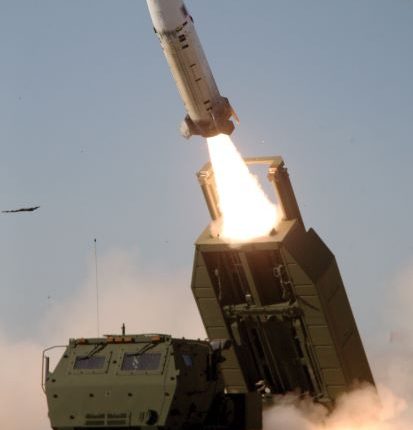US secretly shipped new long-range missiles to Ukraine

By Eric Schmitt
WASHINGTON — The United States last week secretly shipped a new long-range missile system to Ukraine, and Ukrainian forces immediately used the weapons to attack a Russian military airfield in Crimea on April 17 and Russian troops in the country’s southeast overnight Tuesday (23), according to a senior US official.
The United States previously supplied Ukraine with a version of the Army Tactical Missile Systems — known as ATACMS — armed with wide-spreading cluster munitions that can travel 100 miles.
But Ukraine has long coveted the system’s longer-range version, with a range of about 190 miles, which can reach deeper into occupied Ukraine, including Crimea, a hub of Russian air and ground forces, and supply nodes for Moscow’s forces in the country’s southeast.
Overnight Tuesday, Ukraine used the longer-range missiles to strike Russian troops in the port city of Berdyansk on the Sea of Azov, the senior US official said, speaking on the condition of anonymity to discuss operational matters.
On April 17, social media accounts in Ukraine reported large fires and explosions at a military airfield in Dzhankoi, Crimea, which the senior administration official said was also a long-range ATACMS target. In an address that evening, Ukrainian President Volodymyr Zelenskyy thanked Gen. Oleksandr Syrsky, the top Ukrainian commander, but did not elaborate on the attack.
In a major policy shift, President Joe Biden secretly approved the decision to send more than 100 of the longer-range missiles in mid-February, the senior US official said, as well as more of the cluster munition variant. They were part of a $300 million shipment of weapons to Ukraine in March, the first new aid package for the country since funding ran out in late December.
Administration officials kept the shipment secret to avoid tipping off the Russians. When the United States has provided long-range weapons to Ukraine in the past, the Ukrainians have initially inflicted severe damage on Russian forces. But the Russians then pull back their forces and arms depots out of the weapons’ range until Ukraine can employ a new donated system with longer reach. The longer-range ATACMS were among the last major weapons systems that Ukraine wanted and the United States was reluctant to give.
Biden and his top aides dropped their reluctance to donate the longer-range missiles for several reasons, the official said. The Army decided to keep more of the missiles rather than sell them to other countries, easing Pentagon concerns about shortages. Russia’s increasing use of ballistic missiles and more attacks against critical infrastructure also bolstered Ukraine’s plea for weapons that could help counter those threats.
Additional longer-range missiles were also included in the $60.8 billion of aid for Ukraine that was part of legislation Biden signed Wednesday. In praising the infusion of military assistance, including the new missiles, lawmakers and Zelenskyy have made no mention of the fact that Ukraine had already received and employed a small number of the weapons, presumably to keep their use secret from Russia.
The initial strike using the new missiles made a fiery impact. Videos posted online by residents last week showed fires erupting after the attack. The videos have not been independently verified. Four hours after the strike, Crimean Wind, a group monitoring local social media posts that also cites residents, wrote that ammunition was still blowing up. They said windows were blown out in houses near the airfield. Its account also could not be independently verified.
Later, the Ukrainian General Staff released a video of the missile strike detailing what Ukrainian security officials said had been hit — four S-400 surface-to-air missile systems, three radar stations, an air defence command post and a Fundament-M air defence command and control system.
The $300 million arms package announced last month was cobbled together from savings on contracts that came in under bid and included air defence interceptors, artillery rounds and armour systems, senior defence officials said.
Biden administration officials acknowledged that the arms package in March was a stopgap measure at best, providing Ukraine with only a few weeks’ worth of arms and ammunition. Ukraine is in need of air defence systems, as Russia has continued its bombardment of towns, particularly in the east.
Key members of Congress were notified at the time that the secret shipment of ATACMS was included in that package, but Biden administration officials made no public mention that either type of ATACMS was bound for Ukraine.
The strike last week followed a number of successful Ukrainian attacks on military targets inside Russia. The day before the strike, for example, the Ukrainian security service claimed to have destroyed a long-range radar located 434 miles beyond Ukraine’s border. But those used kamikaze-type drones produced in Ukraine.
U.S. military officials have warned that their arsenal of ATACMS is relatively small, and the missiles have been committed for other Pentagon war plans, in places including the Korean Peninsula. Only about 4,000 ATACMS have been manufactured since the missile was developed in the 1980s, according to Lockheed Martin, the system’s manufacturer.
Still, many advocates of arming Ukraine have dismissed the Biden administration’s fear of escalating the conflict with Russia and have urged the White House to give the country the weapons Ukrainian officials say they need to win.
Shortly after Ukraine launched its counteroffensive last summer, House Republicans called on the Biden administration to “immediately” send ATACMS to Ukraine, noting that other allies including Britain and France had already donated long-range missiles.
In the past few days, Russian troops have entered several villages in eastern Ukraine, as Ukrainian troops continue to struggle to hold their lines.
Russia has advanced quickly into the outskirts of Chasiv Yar, a crucial town for Ukraine’s defence of the Donbas region. Russian forces also continued capturing villages northwest of Avdiivka, which fell to Russia in February.
-New York Times


Comments are closed, but trackbacks and pingbacks are open.